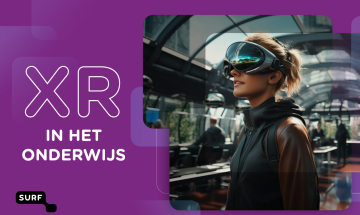"Making up situations and scenarios for people so they can practice what they find difficult."
What are the possibilities, opportunities, applications, challenges and obstacles of eXtended Reality for education? Who are engaged in this? Where are we now and where are we going? Read about it in the issue XR in education.
Translate your education from real to virtual life
From an educational point of view, there are several things to consider when getting started with XR. Important ones include how do you translate your education into an XR application and who do you involve?

Astrid Timman (HAN) worked as a therapist for many years. "Actually, I still do exactly the same now as I used to: make up situations and scenarios for people so they can practise what they find difficult. I used to do that in real life and now in a virtual world. The switch to VR was actually very small for me."
Same route
As a teacher of drama therapy at HAN, Timman follows the same route for the development of her VR education as for regular education. "You first establish your final qualifications, which you then translate into learning outcomes, test forms and learning situations. Then you start looking at what the technical possibilities are, what you want to measure, what story and words you want to use, what the feedback possibilities are and what effect you want."
Beautiful and challenging trajectories
Devising and developing XR concepts and modules for education requires teamwork that includes programmers, developers, educationalists, teachers and preferably students. "They are beautiful but often challenging trajectories. Because you always have to provide customisation and it also requires sufficient manpower and skills in programming and all kinds of graphics. At the RUG, we work on XR with the visualisation team, which consists of six people," says Gert-Jan Verheij.
"It is valuable when students contribute to application development themselves through co-creation."
Being able and allowed to fail
John Walker (SURF) finds it valuable when students themselves contribute to application development through co-creation. "After all, they are going to use them and can probably identify well what the key success and fun factors are. And for students, VR also remains a great place to be able and allowed to fail. You shouldn't underestimate that because it helps them come up with answers and solutions faster and faster."
Engagement and motivation
Arno Freeke (TU Delft) also endorses the importance of co-creation. "Students are very important to us. Our lab was created from their student assistantship and pioneering role. So they really can do something. And some have happily stuck with us. Students can take an elective with us where they design a virtual world." Timman also actively involves her students in developing VR modules. "I always put a lot of initiative with the student, which also fits with my educational vision: really working at the front and making education together. That also leads to more involvement and motivation among students."
Detailed scenario
When it comes to storytelling, Timman also works a lot with her students. "For the development of our VR module to practice conversation techniques with clients, I had students reenact all kinds of situations. We filmed all those and then started working out the scenario for Max, our virtual client. We complete such a scenario in great detail. As a student, you have to pay attention to many things in such a conversation. What do you say and what not. When do you say something and in what tone do you do it. How do you react to non-verbal signals and follow the right steps. These are all things students can score points on. So a good story and a comprehensive script are very important."
"Sometimes the storyline is a classic script and sometimes a process description."
From script to process description
When it comes to storytelling, Freeke also says that for XR, one image sometimes says more than a thousand words. "Those images are often already the story. But there is obviously more to it. For instance, as a student, do you understand how the controls work and do you know exactly what to do within a task? It really varies a lot per application what the storyline is. Sometimes it's a classic script and sometimes a process description. And you also increasingly see that the teaching philosophy, didactics and learning objective become part of the story."
Didactic and psychological aspects
Walker thinks simulations can be further improved and broadened by paying more attention to storytelling. "Both in the form of good and inspiring stories and by focusing more on didactic and psychological aspects. This will hopefully also give arts and humanities a place within the Metaverse."
